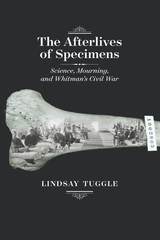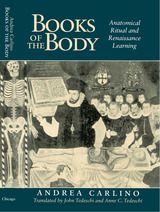
Grounded in archival discoveries, Afterlives traces the origins of nineteenth-century America’s preservation compulsion, illuminating the influences of botanical, medical, spiritualist, and sentimental discourses on Whitman’s work. Tuggle unveils previously unrecognized connections between Whitman and the leading “medical men” of his era, such as the surgeon John H. Brinton, founding curator of the Army Medical Museum, and Silas Weir Mitchell, the neurologist who discovered phantom limb syndrome. Remains from several amputee soldiers whom Whitman nursed in the Washington hospitals became specimens in the Army Medical Museum.
Tuggle is the first scholar to analyze Whitman’s role in medically memorializing the human cadaver and its abandoned parts.

In Books of the Body, Andrea Carlino explores the nature and causes of this intellectual inertia. On the one hand, anatomical practice was constrained by a reverence for classical texts and the belief that the study of anatomy was more properly part of natural philosophy than of medicine. On the other hand, cultural resistance to dissection and dismemberment of the human body, as well as moral and social norms that governed access to cadavers and the ritual of their public display in the anatomy theater, also delayed anatomy's development.
A fascinating history of both Renaissance anatomists and the bodies they dissected, this book will interest anyone studying Renaissance science, medicine, art, religion, and society.

Human Structure is an innovative introduction to human gross anatomy with a twofold approach to view the basics of anatomy from a broad scientific perspective and to explain the facts of form and function in terms and concepts that minimize the usual confusion and anxiety of beginning anatomy studies. Functional, comparative, and developmental anatomy are ingeniously woven into a single explanatory perspective, presenting human anatomy as an intelligible whole rather than as a heap of disconnected facts to be memorized. As a result, Human Structure is suitable not only for first-year medical students but also for undergraduates in premedical or biological science courses, for students in paramedical or college-level nursing programs, and indeed for anyone seeking a refresher course in human anatomy.
The book begins with the generalized segmental organization characteristic of vertebrates and then examines the most obviously segmented parts of the human body: the bones, muscles, vessels, and nerves of the trunk between the neck and the pelvis. The book progresses through regions where the simple organizational plan has undergone more and more radical modifications and ends with the ancient and extreme specializations found in the head. At each step, the authors widen our intellectual understanding of how these modifications have been imposed, onto-genetically or phylogenetically, upon simpler precursors.
The prose is personal and literate, peppered with inventive elucidations of concepts and accompanied by a wealth of illustrations designed for conceptual clarity and ease of visualization. The level of presentation has been finely tuned, over several years of class testing, to enhance its pedagogical effectiveness in human anatomy courses.

READERS
Browse our collection.
PUBLISHERS
See BiblioVault's publisher services.
STUDENT SERVICES
Files for college accessibility offices.
UChicago Accessibility Resources
home | accessibility | search | about | contact us
BiblioVault ® 2001 - 2024
The University of Chicago Press









